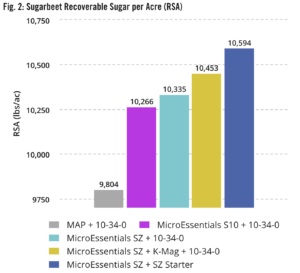OVERVIEW
- MAP + 10-34-0 is commonly used as a primary phosphate fertilizer source in sugarbeet-growing regions of North America.
- In addition to N, P, K, sugarbeets are very responsive to Mg, S and Zn.
- Mg plays a very important role in phloem loading of sucrose. Phloem export of sucrose is severely impaired at a very early stage of Mg deficiency, even before any noticeable changes appear in shoot growth.
TRIAL DETAILS
Crop: Sugarbeet (Beta vulgaris)
Years: 2010-2012
Data Source: North Dakota State University, Fargo, N.D.
Experimental Design: Small-plot RCBD with 4 replications.
Experimental Design: Small-plot RCBD with 4 replications
Cropping Conditions:
P Rate: Balanced across treatments at 35 lbs P₂O₅/ac.
K Rate: Balanced across treatments at 60 lbs K₂O/ac.
Liquid Starter: 3 gal/ac
RESULTS


SUMMARY
- Treatments including MicroEssentials® S10® and MicroEssentials® SZ® resulted in higher root yield and RSA than the MAP treatment alone.
- MicroEssentials® SZ® + MicroEssentials® SZ® as starter produced the highest root yield and RSA, which were 12% and 8% higher than MAP+10-34-0, respectively.
- The second-highest root yield and RSA were produced with MicroEssentials® SZ® + K-Mag®, which can be explained by the role of Mg in sugar transport to the roots.
- MicroEssentials® and K-Mag® are superior alternatives to the common practice of MAP.